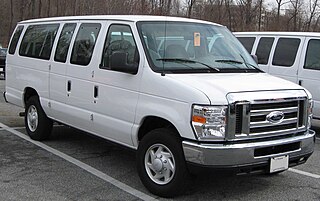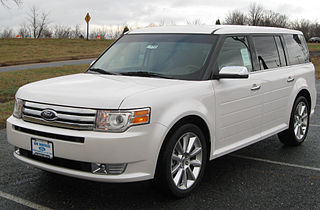
Minivan is a North American car classification for vehicles designed to transport passengers in the rear seating row(s), with reconfigurable seats in two or three rows. The equivalent classification in Europe is the M-segment, more commonly known as an MPV or a people carrier / mover. Minivans often have a 'one-box' or 'two-box' body configuration, a higher roof, a flat floor, a sliding door for rear passengers, and high H-point seating.

Mercury is a defunct division of the American automobile manufacturer Ford Motor Company. Created in 1938 by Edsel Ford, Mercury was marketed as an middle priced brand for nearly its entire existence, bridging the price gap between the Ford and Lincoln model lines. Competing against Oldsmobile within General Motors, Mercury also competed most directly against Chrysler's DeSoto, Hudson and Studebaker.

The Ford Windstar is a minivan that was produced and sold by Ford. The replacement for the Ford Aerostar, the Windstar adopted the front-wheel drive configuration of the Chrysler minivans. From the 1995 to 2007 model years, three generations of the model line were sold, with the final generation renamed as the Ford Freestar.

The Mazda MPV is a minivan manufactured by Mazda. Introduced in 1988 as a rear-wheel-drive model with optional selectable four-wheel drive, this was replaced in 1999 with a front-wheel-drive version with optional all-wheel-drive in some markets. Over one million MPV models have been produced since its introduction.

The Mazda Bongo, also known as Mazda E-Series and the Ford Econovan, is a van and pickup truck manufactured by the Japanese automobile manufacturer Mazda since 1966, in a cabover configuration except for the Friendee variant. It has been built with rear-, middle-, as well as front-mounted engines. It also formed the basis for the long running Kia Bongo range. It is named for the African Bongo, a type of antelope.

The Chrysler minivans are a series of minivans that have been produced and marketed by the American automaker Chrysler. In production since the 1984 model year, Chrysler has produced six distinct generations of minivans; at various stages of their production, Chrysler minivans have been marketed worldwide, primarily in North America and Europe.

The Ford E-Series is a range of full-size vans produced by the American automaker Ford. Introduced for the 1961 model year as the replacement for the Ford F-series panel van, the model line is currently in its fourth generation.

The Mercury Villager is a minivan that was marketed by the Mercury division of Ford. The first of two minivans sold by Mercury, two generations were sold from the 1993 to 2002 model years. Competing against the Chrysler minivans and the General Motors APV minivans, the front-wheel drive Villager was introduced between the Ford Aerostar and the Ford Windstar.

The Ford Aerostar is a range of vans that was manufactured by Ford from the 1986 to the 1997 model years. The first minivan produced by Ford, the model line was marketed against the Chevrolet Astro/GMC Safari and the first two generations of the Chrysler minivans. Introduced shortly before the Ford Taurus, the Aerostar derived its name from its slope-nosed "one-box" exterior.

The Ford Essex V6 engine is a 90° V6 engine family that was built by Ford Motor Company at the Essex Engine Plant in Windsor, Ontario, Canada. Unlike the British Essex V6, the Canadian Essex used a 90° Vee configuration, in addition to having different displacements and valvetrains. This engine was succeeded by the Ford Duratec 35, and the last one produced was found in 2008 F-150.

The Chevrolet Lumina APV is a minivan that was produced by the Chevrolet division of General Motors. The first front-wheel drive minivan sold by Chevrolet, the Lumina APV was sold in a single generation from the 1990 to 1996 model years. Marketed alongside the Pontiac Trans Sport and Oldsmobile Silhouette, the Lumina APV competed against the Dodge Grand Caravan/Plymouth Grand Voyager, the extended-length Ford Aerostar, and the Mazda MPV.

The Ford Transit Connect is a compact panel van developed by Ford Europe. It is built on a dedicated commercial vehicle platform and shares parts with the Ford Focus. The first generation was designed by Peter Horbury and introduced in 2002 to replace the older Ford Escort and Fiesta-based Courier van ranges, which had ceased production in the same year. It has been imported to the North American market since the 2010 model year. In North America, the Transit Connect does not have a direct predecessor; the closest vehicle to its size was the standard-length Ford Aerostar cargo van, which ceased production in 1997.

The Nissan Quest is a minivan that was marketed by Nissan from the 1993 to 2017 model years. The first Nissan minivan developed specifically for North American sale, the Quest replaced the Nissan Vanette and Nissan Axxess in the United States and Canada. Competing against the Chrysler minivans, the Quest was the first Japanese-brand minivan manufactured in the United States, leading to the later Honda Odyssey and Toyota Sienna.

The Ford Flex is a full-size crossover SUV or wagon that was manufactured by the Ford Motor Company; a single generation was produced from the 2009 to 2019 model years. Introduced as the successor to the Ford Taurus X, the model line also functionally replaced the Ford Freestar minivan. Slightly larger than its predecessor, the Flex was sized between the Explorer and standard-wheelbase Expedition in the Ford model line.
In the context of the automobile industry, downsizing is a practice used to transition vehicles from one size segment to another. Often done in response for consumer and government demands to increase fuel economy, vehicle downsizing has been achieved through several methods. As product lines complete model cycles, during a redesign, automobile manufacturers reduce the exterior footprint of a vehicle to allow for weight reduction, shortening wheelbase and body length.

The Mazda Premacy is a compact MPV that was built by the Japanese manufacturer Mazda from 1999.
The Ford Carousel is a prototype vehicle that was developed by Ford in 1973. A derivative of the third-generation Ford Econoline/Club Wagon, the Carousel explored a number of the concepts that 1980s American-market minivans later put into production, serving as an alternative to both full-size station wagons and passenger vans.

The first-generation Chrysler minivans are a series of minivans produced and marketed by the Chrysler Corporation from the 1984 to the 1990 model years. In a product introduction that would popularize the minivan as a vehicle in North America, Chrysler introduced the Dodge Caravan and the Plymouth Voyager, launched ahead of chief competitors Chevrolet Astro/GMC Safari and Ford Aerostar.

The RS-platform Chrysler minivans are a series of passenger minivans marketed by Chrysler from model years 2001 to 2007, the fourth in six generations of Chrysler minivans, which were heavily revised versions of the NS minivans. Depending on the market, these vans were known as the Dodge Caravan, Chrysler Town & Country, and the Chrysler Voyager. With the discontinuation of the Plymouth brand, the Plymouth Voyager didn't return.

The third-generation Chrysler minivans are a series of passenger minivans that were marketed by the Chrysler Corporation from the 1996 to 2000 model years. Designated the NS platform by Chrysler, these minivans were sold by Chrysler, Dodge and Plymouth divisions in passenger configurations; minivans were exported under the Chrysler brand. While the second-generation AS platform was a revision of the original vans, the NS platform marked the first ground-up redesign of the Chrysler vans since their 1984 introduction, ending the use of components from K-Car derivatives.

















